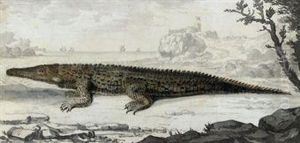Clement Lempriere Paintings
Clement Lempriere, an artist of the 17th and 18th centuries, is a figure around whom details are somewhat scarce, yet his contributions to cartography and topographical drawings mark him as a notable figure in the history of British art and map-making. Born in 1683, Lempriere's early life is not extensively documented, but it is evident that his interests and talents lay in the realm of detailed drawing and mapping, skills that were highly valued in a period of expanding geographical exploration and military engineering.
Lempriere is perhaps best known for his work as a cartographer, particularly for his detailed maps of the Channel Islands, his place of origin. These maps were not only significant for their navigational utility but also for their artistic merit, showcasing Lempriere's ability to blend accuracy with aesthetic appeal. His work during this period reflects the broader trends in European cartography, moving towards more scientifically accurate and empirically based representations of geography, yet still retaining elements of artistry and decoration that were characteristic of earlier map-making traditions.
Aside from his cartographic achievements, Clement Lempriere also engaged in creating topographical drawings and watercolors, capturing the landscapes and architectural features of his environment. These works, while perhaps less known than his maps, further demonstrate his keen eye for detail and his ability to convey the essence of a place through his art. Lempriere's contributions in this area provided valuable visual records of landscapes and buildings, some of which may have changed or no longer exist.
Lempriere's career also intersected with the military and engineering projects of his time, as his skills in detailed drawing and mapping were in demand for the planning and execution of military fortifications and other engineering works. This aspect of his work underscores the practical applications of his artistic talents, bridging the gap between art and science in a way that was typical of the Enlightenment period.
Clement Lempriere's death in 1746 marked the end of a career that had spanned some of the most significant developments in cartography and topographical art. While he may not be as widely recognized as some of his contemporaries, Lempriere's work remains an important part of the history of British cartography and provides a fascinating glimpse into the visual and scientific culture of his time. His maps and drawings, preserved in collections and archives, continue to be studied and admired for their historical value and artistic beauty.
